Chennai to KanyaKumari Trip - 7 Days Trip
1st Day - Pondicherry
Pondicherry is a living monument of French culture in India. The town was once upon a time, an abode of scholars well versed in the Vedas. Joseph François Dupleix became the Governor of this French Territory in India. Internal disturbances in Puducherry gave the British, the opportunity to gain control. However, after the Treaty of Paris, the British restored the settlements to the French. French Influence - The design of the city was based on the French grid pattern. (Originally Dutch, the plans of Pondicherry dating from the end of the seventeenth century are preserved in the National Archives at The Hague). The city has many colonial buildings, churches, temples and statues, which, combined with the systematic town planning and the well planned French style avenues, still preserve much of the colonial ambience. Beaches in Puducherry are Promenade Beach, Paradise Beach, The Auroville Beach and Serenity Beach. Sri Aurobindo Ashram is one of the best-known and wealthiest ashrams in India. Auroville is meant to be a universal town where men and women of all countries are able to live in peace and progressive harmony, above any creed, politics and nationalities. The heritage buildings and monuments present around the Promenade beach are the Children's Park & Dupleix Statue, Gandhi statue, Nehru Statue, Le Café, French War Memorial, 19th Century Light House, Bharathi Park, Governor's Palace, Romain Rolland Library, Legislative Assembly, Puducherry Museum and the French Institute of Pondicherry.
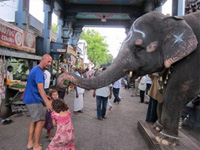 Sri Manakula Vinayagar Temple - The French and the British tried to remove the deity from this place and even threw the deity in the sea. But the deity came back to the same place. Peace Of Mind - PONDICHERRY SRI MANAKULA VINAYAGAR TEMPLE was in existence even before the French came and settled in Pondicherry i.e. before 1666. The local people called their God as Manal Kulathu Vinayagar meaning God near the pond of sand. Later it was known as MANAKULA VINAYAGAR. The Jesuits and missionaries tried but could not demolish Manakula Vinayagar temple. The French and the British lived in this part of the town. They made every effort to remove the deity from this place and even threw the deity in the sea but every time they did this, the deity came back to the same place. Later a temple was built near the shores of the Bay of Bengal as per the Ganapathy Agamam and was named Bhuvanesa Vinayagar Temple. Thollaikkathu Siddhar, a saint standing 6ft tall, with broad forehead, glittering blissful eyes, big hole bearing ear, small pot bellied with hand extending up to knee cap and hands with lotus regai, guru medu and sanimedu at a height showing arul gnana regai, got enlightenment from this deity and attained Samadhi in this temple, nearly 300 years ago. From then on, people bring their new born here for worship before going to any other temple. The temple is 300 years old and its early history is marked by trouble, with the French ordering that the annual festival around the streets of Pondicherry should not take place. This caused unrest among the people and 15,000 of them gathered to set off towards Chennai. As they were all workers in a textile factory, the authorities revoked their decision, fearing that work would be affected. This type of incident kept repeating till, strangely, Dupleix, the great French leader himself developed affection for the idol. Such are the winning ways of Lord Vinayaka! who lives in a region bound by sand". To the Eastern side of the temple lies the sea and the sand. Inside the temple, there is a small pond, which the priest will show to the devotee with the help of a lit camphor. Though the pond is close to the sea, the water is clear. It is believed that anything put into the pond will turn black in colour.
Sri Manakula Vinayagar Temple - The French and the British tried to remove the deity from this place and even threw the deity in the sea. But the deity came back to the same place. Peace Of Mind - PONDICHERRY SRI MANAKULA VINAYAGAR TEMPLE was in existence even before the French came and settled in Pondicherry i.e. before 1666. The local people called their God as Manal Kulathu Vinayagar meaning God near the pond of sand. Later it was known as MANAKULA VINAYAGAR. The Jesuits and missionaries tried but could not demolish Manakula Vinayagar temple. The French and the British lived in this part of the town. They made every effort to remove the deity from this place and even threw the deity in the sea but every time they did this, the deity came back to the same place. Later a temple was built near the shores of the Bay of Bengal as per the Ganapathy Agamam and was named Bhuvanesa Vinayagar Temple. Thollaikkathu Siddhar, a saint standing 6ft tall, with broad forehead, glittering blissful eyes, big hole bearing ear, small pot bellied with hand extending up to knee cap and hands with lotus regai, guru medu and sanimedu at a height showing arul gnana regai, got enlightenment from this deity and attained Samadhi in this temple, nearly 300 years ago. From then on, people bring their new born here for worship before going to any other temple. The temple is 300 years old and its early history is marked by trouble, with the French ordering that the annual festival around the streets of Pondicherry should not take place. This caused unrest among the people and 15,000 of them gathered to set off towards Chennai. As they were all workers in a textile factory, the authorities revoked their decision, fearing that work would be affected. This type of incident kept repeating till, strangely, Dupleix, the great French leader himself developed affection for the idol. Such are the winning ways of Lord Vinayaka! who lives in a region bound by sand". To the Eastern side of the temple lies the sea and the sand. Inside the temple, there is a small pond, which the priest will show to the devotee with the help of a lit camphor. Though the pond is close to the sea, the water is clear. It is believed that anything put into the pond will turn black in colour.
2nd Day - Kumbakonnam
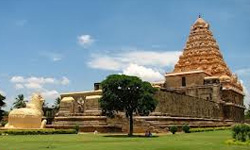 Gangaikonda Cholapuram was erected as the capital of the Cholas by Rajendra Chola I, the son and successor of Rajaraja Chola, the great Chola King who conquered a large area in South India at the beginning of the 11th century. His empire included the whole of Southern India up to river Thungabadhra in the north. For administrative and strategic purposes he built another capital and named it Gangaikondacholapuram. The Gangaikondacholapuram Temple he constructed consists of 3 stories and was surrounded by a huge wall like fort. The outer wall was mostly destroyed during the English rule 1896 A.D and the granite rocks were reused?for constructing the Lower Anicut Dam across river Kollidam. Chola rulers were active patrons of arts. They flourished in architecture, education, science, arts, ship construction, poetry, drama, music, commerce and dance. The beautiful Nataraja statue was first conceived during the Chola Empire. Judging from the available literature and from the remains we can conclude, that it was an extensive city, carefully planned and laid in accordance with the architectural treatises to suit the needs of a capital. The city seems to have had two fortifications, inner and outer. The outer was probably wider. The remains of the outer fortification can be seen as a mound running all around the palace. The outer fortification built of burnt bricks, was about six to eight feet wide. It consisted of two walls, the intervening space or the core was filled with sand. The bricks are fairly large in size and were made of well-burnt clay. Systematic brick robbing by the local inhabitants has reduced this structure to its current state. The outer fortification was known as Rajendra Chola Madil and is mentioned in the inscriptions. The inner fortification was around the royal palace, probably identical with the Utpadi Vittu Madil of the inscriptions. Kulothunga Chola I also built a sculptural temple at Melakadambur, which is a wonderful masterpiece of Chola art. By the 13th century, the Chola kingdom had exhausted its resources and was on the decline. It succumbed to an attack by the Hoysalas from the west and the Pandyas from the south. The Chola administration served as a model for all the other kingdoms of the South. The king had a Council of Ministers. The kingdom was divided into a number of provinces known as Mandalams; the mandalams in turn were divided into Valanadu and Nadus. The next administrative sub divisions were kurrams and kottams. The special feature of the Chola administration was the Local Self Government or autonomous administration. The villagers themselves carried out village administration. It was more or less like the modern day Panchayat Raj. Each village had a village assembly known as the Ur or the sabha. The members of the sabha were elected by lots, known as Kudavolai system. There was a committee to look after the specified departments, such as justice, law and?order, irrigation etc., which were called as variyams. The Temple of Gangaikondacholisvara, the great Vimana arrests the visitor's sight. As it rises to a height of 182 feet windows 8 key and is shorter than the Thanjavur tower with larger plinth, it is often described as the feminine counterpart of the Thanjavur temple. The Gangaikondacholapuram Vimana is undoubtedly a Devalaya Chakravarti, an emperor among temples of South India. The royal palace was also built of burnt bricks. The ceilings were covered with flat tiles of small size, laid in a number of courses, in fine lime mortar. The pillars were probably made of polished wood, supported on granite bases. A few pillar bases have survived to this day. Iron nails and clamps have been recovered from this palace site. There is an underground tunnel that links the palace and the inner temple. It is likely that there was more than one royal building each having its own name and must have been a splendid site. Besides the names of the palace and fort walls, the names of a few roads and streets are preserved in the epigraphs. There were both wet and dry lands inside the Fort, used for cultivation and other purposes. The present position of the existing temples throws some light on the lay out of the city. The great temple and other temples have been erected, with the palace at the centre of the city. Towards the northeast Isanya of the palace, is the great temple of Shiva which according to Vastu and traditional texts, should be in the north -east side of the city or village and should face east. The capital of the most powerful empire in Asia at one time now lies deserted, only the temple of Gangaikondachola survives in GangaiKondaCholapuram. What caused the destruction of this city? - The Pandyas who put an end to the Chola Empire late in the 13th century, took revenge for their earlier defeats, and razed the city to the ground, a misfortune that befell capitals in the bygone ages. It remained a mountain of brick debris. The inhabitants of the nearby villages stole the bricks for their own construction. The people have also dug systematically deep into the ground and extracted cartloads of ancient bricks.
Gangaikonda Cholapuram was erected as the capital of the Cholas by Rajendra Chola I, the son and successor of Rajaraja Chola, the great Chola King who conquered a large area in South India at the beginning of the 11th century. His empire included the whole of Southern India up to river Thungabadhra in the north. For administrative and strategic purposes he built another capital and named it Gangaikondacholapuram. The Gangaikondacholapuram Temple he constructed consists of 3 stories and was surrounded by a huge wall like fort. The outer wall was mostly destroyed during the English rule 1896 A.D and the granite rocks were reused?for constructing the Lower Anicut Dam across river Kollidam. Chola rulers were active patrons of arts. They flourished in architecture, education, science, arts, ship construction, poetry, drama, music, commerce and dance. The beautiful Nataraja statue was first conceived during the Chola Empire. Judging from the available literature and from the remains we can conclude, that it was an extensive city, carefully planned and laid in accordance with the architectural treatises to suit the needs of a capital. The city seems to have had two fortifications, inner and outer. The outer was probably wider. The remains of the outer fortification can be seen as a mound running all around the palace. The outer fortification built of burnt bricks, was about six to eight feet wide. It consisted of two walls, the intervening space or the core was filled with sand. The bricks are fairly large in size and were made of well-burnt clay. Systematic brick robbing by the local inhabitants has reduced this structure to its current state. The outer fortification was known as Rajendra Chola Madil and is mentioned in the inscriptions. The inner fortification was around the royal palace, probably identical with the Utpadi Vittu Madil of the inscriptions. Kulothunga Chola I also built a sculptural temple at Melakadambur, which is a wonderful masterpiece of Chola art. By the 13th century, the Chola kingdom had exhausted its resources and was on the decline. It succumbed to an attack by the Hoysalas from the west and the Pandyas from the south. The Chola administration served as a model for all the other kingdoms of the South. The king had a Council of Ministers. The kingdom was divided into a number of provinces known as Mandalams; the mandalams in turn were divided into Valanadu and Nadus. The next administrative sub divisions were kurrams and kottams. The special feature of the Chola administration was the Local Self Government or autonomous administration. The villagers themselves carried out village administration. It was more or less like the modern day Panchayat Raj. Each village had a village assembly known as the Ur or the sabha. The members of the sabha were elected by lots, known as Kudavolai system. There was a committee to look after the specified departments, such as justice, law and?order, irrigation etc., which were called as variyams. The Temple of Gangaikondacholisvara, the great Vimana arrests the visitor's sight. As it rises to a height of 182 feet windows 8 key and is shorter than the Thanjavur tower with larger plinth, it is often described as the feminine counterpart of the Thanjavur temple. The Gangaikondacholapuram Vimana is undoubtedly a Devalaya Chakravarti, an emperor among temples of South India. The royal palace was also built of burnt bricks. The ceilings were covered with flat tiles of small size, laid in a number of courses, in fine lime mortar. The pillars were probably made of polished wood, supported on granite bases. A few pillar bases have survived to this day. Iron nails and clamps have been recovered from this palace site. There is an underground tunnel that links the palace and the inner temple. It is likely that there was more than one royal building each having its own name and must have been a splendid site. Besides the names of the palace and fort walls, the names of a few roads and streets are preserved in the epigraphs. There were both wet and dry lands inside the Fort, used for cultivation and other purposes. The present position of the existing temples throws some light on the lay out of the city. The great temple and other temples have been erected, with the palace at the centre of the city. Towards the northeast Isanya of the palace, is the great temple of Shiva which according to Vastu and traditional texts, should be in the north -east side of the city or village and should face east. The capital of the most powerful empire in Asia at one time now lies deserted, only the temple of Gangaikondachola survives in GangaiKondaCholapuram. What caused the destruction of this city? - The Pandyas who put an end to the Chola Empire late in the 13th century, took revenge for their earlier defeats, and razed the city to the ground, a misfortune that befell capitals in the bygone ages. It remained a mountain of brick debris. The inhabitants of the nearby villages stole the bricks for their own construction. The people have also dug systematically deep into the ground and extracted cartloads of ancient bricks.
 Darasuram Temple and site seeing - This 12th Century AD Airavateswarar Temple in Darasuram (originally called Raja Rajeswaram) was the third in the series of temples built by the great Chozha Kings of that time. Darasuram's Airavateswarar temple,built by Raja Raja Chozhan II,is a marvel and a standing example of the architectural expertise and 'work on stone' of the Chozha kings. The Jagannath Puri temple in Konark is believed to have taken inspiration from Darasuram's architectural master piece. It is believed that this name might have been corrupted to Darasuram with the passage of time. The sanctum is in the form of a chariot. This temple is a storehouse of art and architecture. The vimana is 85 feet high. The front mandapam itself is in the form of a huge chariot drawn by horses. The temple has some exquisite stone carvings. The main deity's consort Periya Nayaki Amman temple is situated adjacent to Airavateshwarar temple. The Great Living Chola Temples (a UNESCO World Heritage Site) at Thanjavur, Gangaikonda Cholapuram and Darasuram were built by the Cholas between the 10th and 12th centuries CE and have a lot of similarities.
Darasuram Temple and site seeing - This 12th Century AD Airavateswarar Temple in Darasuram (originally called Raja Rajeswaram) was the third in the series of temples built by the great Chozha Kings of that time. Darasuram's Airavateswarar temple,built by Raja Raja Chozhan II,is a marvel and a standing example of the architectural expertise and 'work on stone' of the Chozha kings. The Jagannath Puri temple in Konark is believed to have taken inspiration from Darasuram's architectural master piece. It is believed that this name might have been corrupted to Darasuram with the passage of time. The sanctum is in the form of a chariot. This temple is a storehouse of art and architecture. The vimana is 85 feet high. The front mandapam itself is in the form of a huge chariot drawn by horses. The temple has some exquisite stone carvings. The main deity's consort Periya Nayaki Amman temple is situated adjacent to Airavateshwarar temple. The Great Living Chola Temples (a UNESCO World Heritage Site) at Thanjavur, Gangaikonda Cholapuram and Darasuram were built by the Cholas between the 10th and 12th centuries CE and have a lot of similarities.
The lingam is believed to have been worshipped by Indra's white elephant (Airavatham) and hence the name 'Airavateswarar'. The Lord of Death, Yama, once incurred the wrath of a rishi and was cursed to have burning sensation all over his body. Yama is said to have visited this temple and invoked the blessings of Lord Airavateswarar by bathing in the temple tank. Pleased with his prayers, Airavateswarar is said to have liberated Yama from his curse. It is said that the King of Death, Yama also worshipped Shiva here. Tradition has it Yama, who was suffering under a Rishi's curse from a burning sensation all over the body, was cured by the presiding deity Airavatesvarar. Yama took bath in the sacred tank and got rid of the burning sensation. Since then the tank has been known as Yamateertham.
3rd Day - Thanjavur & site Seeing
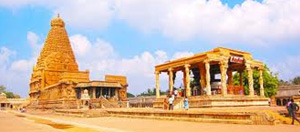 Thanjavur is the home of Tanjore painting that is unique and popular around the world. It is one of the oldest cities in India and has a long and varied history. The city rose into prominence during the rule of the Later Cholas when it served as the capital of the Chola empire. The historical buildings are the Vijayanagara Fort, which contains a palace, a Bell Tower and the Saraswathi Mahal Library, which contains over 30,000 Indian and European manuscripts written on palm leaf and paper. The Brihadeeshwara Temple built by Rajaraja Chola was completed around 1010 AD. It also acted as a repository of the empire's records, as the great Rajaraja had its walls covered with numerous inscriptions, recording his conquests and his endowments to various charities. The Big Temple is a superb and fascinating monument. Thanjavur has produced many classical musicians and Bharathanatyam dancers. Tanjore is well known for bronze sculptures, unique Tanjore paintings, Thavil, a divine instrument Veena, Thanjavur dolls and Tanjore plates.
Thanjavur is the home of Tanjore painting that is unique and popular around the world. It is one of the oldest cities in India and has a long and varied history. The city rose into prominence during the rule of the Later Cholas when it served as the capital of the Chola empire. The historical buildings are the Vijayanagara Fort, which contains a palace, a Bell Tower and the Saraswathi Mahal Library, which contains over 30,000 Indian and European manuscripts written on palm leaf and paper. The Brihadeeshwara Temple built by Rajaraja Chola was completed around 1010 AD. It also acted as a repository of the empire's records, as the great Rajaraja had its walls covered with numerous inscriptions, recording his conquests and his endowments to various charities. The Big Temple is a superb and fascinating monument. Thanjavur has produced many classical musicians and Bharathanatyam dancers. Tanjore is well known for bronze sculptures, unique Tanjore paintings, Thavil, a divine instrument Veena, Thanjavur dolls and Tanjore plates.
4th Day - Madurai Temple
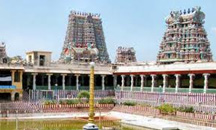 Madurai is the great capital of Pandya Dynasty and centre of Tamil culture and learning. Madurai one of the oldest inhabited cities in India. Madurai's cultural heritage goes back 2,500 years, and the city has conducted trade as far as Rome and Greece since as early as 550 B.C. Madurai's Meenakshi-Sundareswarar temple, which stands today as one of India's greatest cultural and architectural landmarks, was originally built by the early Pandya King Kulasekara. Thirumalai Nayakar Mahal - This palace complex was constructed by Thirumalai Nayakar - The original palace complex was four times bigger than the present structure. The ceilings are decorated with large paintings. The portico was constructed with bricks and mortar without the support of a single rafter or girder. The stucco work on its domes and arches is remarkable. The gigantic pillars and structures represent architectural mastery. The courtyard, the dancing hall and the 248 pillars, each 58 feet tall and 5 feet in diameter are divine attractions for visitors.
Madurai is the great capital of Pandya Dynasty and centre of Tamil culture and learning. Madurai one of the oldest inhabited cities in India. Madurai's cultural heritage goes back 2,500 years, and the city has conducted trade as far as Rome and Greece since as early as 550 B.C. Madurai's Meenakshi-Sundareswarar temple, which stands today as one of India's greatest cultural and architectural landmarks, was originally built by the early Pandya King Kulasekara. Thirumalai Nayakar Mahal - This palace complex was constructed by Thirumalai Nayakar - The original palace complex was four times bigger than the present structure. The ceilings are decorated with large paintings. The portico was constructed with bricks and mortar without the support of a single rafter or girder. The stucco work on its domes and arches is remarkable. The gigantic pillars and structures represent architectural mastery. The courtyard, the dancing hall and the 248 pillars, each 58 feet tall and 5 feet in diameter are divine attractions for visitors.
5th Day - Madurai to KanyaKuari
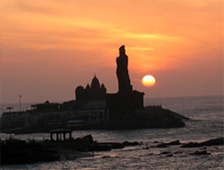 Kanyakumari - Formerly known as Cape Comorin, Kanyakumari is especially popular in India for the confluence of three ocean bodies - the Bay of Bengal, the Indian Ocean and the Arabian Sea. The sunrise and sunset can be seen and also the moon-rise and sunset occur simultaneously on either side of the horizon. On two rocky islets just off the shore, are the Vivekananda Rock Memorial and the gigantic statue of Tamil saint-poet Thiruvalluvar, one of the biggest statues in Asia. One of the rocks, bear the footprints of the virgin Goddess. The Sthanumalayan temple with a repository of art treasures,musical columns and tall statue of Hanuman is located at Suchindram. Padmanabhapuram Palace is a large palace made almost entirely of wood - the only one of its kind in India. Gandhi Memorial is a striking memorial. Kanya Amman Temple - The sparkling diamond nose-ring of the deity is said to be visible even from the sea and is said to guide sailors safely to reach the shore. Sage Agasthya, an expert in medicinal herbs, is believed to have lived around this site in ancient days. Medicinal herbs are found on hills near Kanyakumari.
Kanyakumari - Formerly known as Cape Comorin, Kanyakumari is especially popular in India for the confluence of three ocean bodies - the Bay of Bengal, the Indian Ocean and the Arabian Sea. The sunrise and sunset can be seen and also the moon-rise and sunset occur simultaneously on either side of the horizon. On two rocky islets just off the shore, are the Vivekananda Rock Memorial and the gigantic statue of Tamil saint-poet Thiruvalluvar, one of the biggest statues in Asia. One of the rocks, bear the footprints of the virgin Goddess. The Sthanumalayan temple with a repository of art treasures,musical columns and tall statue of Hanuman is located at Suchindram. Padmanabhapuram Palace is a large palace made almost entirely of wood - the only one of its kind in India. Gandhi Memorial is a striking memorial. Kanya Amman Temple - The sparkling diamond nose-ring of the deity is said to be visible even from the sea and is said to guide sailors safely to reach the shore. Sage Agasthya, an expert in medicinal herbs, is believed to have lived around this site in ancient days. Medicinal herbs are found on hills near Kanyakumari.
6th Day - Back to Madurai - Halt
7th DayBack to Chennai
Note: This is for your kind information that pooja materials, food charges and other expenses have to be borne by the customer directly.
Note: This is for your kind information that pooja materials, food charges and other expenses have to be borne by the customer directly.
Chennai to Navagraha Tip - 3 Days Package
India Someday' - Your travel to India with a little assistance!
A holiday in India will leave you with memories for a lifetime. We want to assist you in planning a well thought, personalized and yet cost-effective Indian holiday.
The sheer variety of places to visit in Tamil Nadu, India and the size of the country make it difficult to plan a two - three days or week India trip. Which places to visit? Which destinations to skip? How to connect from one place to the other?
We are a young, energetic and resourceful in this and that enjoys working closely with our guests to help them plan an exciting Indian holiday experience.
We would like to know more about your intended 'Trip to India', understand the kind of holiday you are looking for and assist you in planning your trip with cost details. Based on your requirements we will help and guide you with all arrangements.
Mission: Our mission is to provide Quality and excellence service to our customers promptly and exclusively."
For further more communication you can contact us directly us thru' online or by telephone communication and through email also as details given below.
Skype Id: astrologypredict108
Contact No: +91 99941 60913 | +91 909 466 2055
E Mail: [email protected]
Quick Contact For Details
- Chennai to KanyaKumari Trip - 7 Days Trip
- Chennai - Kanchipuram to Thirupathi - Kalasthri - chennai Trip - Shot Trip
- Chennai - Pondicherry to Mahabalipura - Chennai - Short Trip
- Chennai to Trivannamalai to Vellore to Chennai Trip
- Nadi Service Supreme Package - A Passport to your Future
- Nava Tirupathi
- Arupadaiveedu Temples - \"Six Battle Camps\" of Muruga
- Panchabhoota Sthalams - Temples of five elements
- Navagraha Trips

